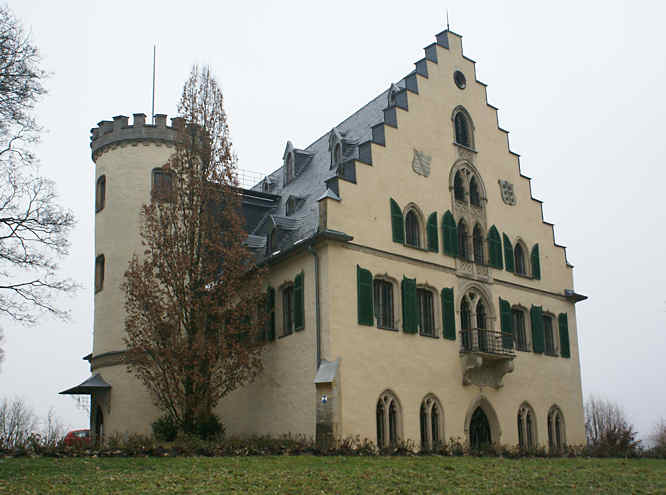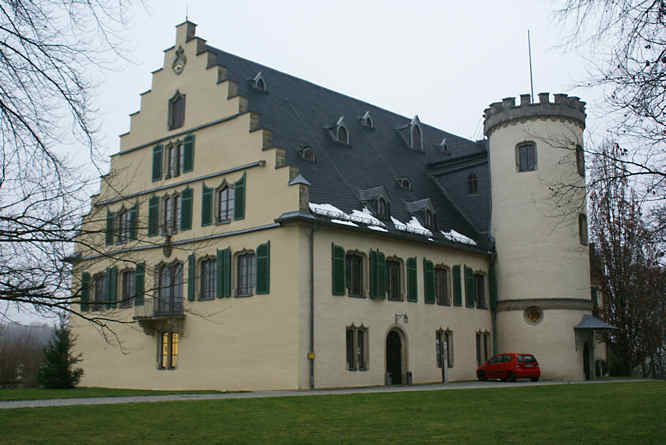Coburg's Schloss Rosenau
The Schloss Rosenau Castle is Queen Victoria's Prince Albert's birth place and where he grew up. It is really a large country house than a castle. Queen Victoria wrote in her diary, 'If I weren't the person who I am, my home would be here.' During her reign she traveled to the Coburg seven times. It normally took two weeks to get there and two weeks to get back to England.

Her Prime Minister Mr Disraeli had to reminder her: 'Your Majesty, you cannot rule the Empire from Coburg.' Queen Victoria made 6 visits to Coburg during her 64 year reign. She had a soft spot for the principality and its palaces because of the connection to her beloved husband Albert and also the fact that her mother also came from the Duchy. She loved its lush forests and gently rolling hills. Prince Albert said he adored the little Schloss in the German forest because in summer he could hear the sound of fountains through open windows and in autumn the roaring of stags.
Schloss Rosenau fell into decline after the overthrow of the German monarchy in 1918. It was used as a hospital in the Second World War and when Prince Charles visited in 1982, he was shocked by its shabby condition. Restoration became a priority and a set of watercolours by Ferdinand Rothbard, showing the rooms as they were in the 1850s, was tracked down to Windsor Castle. Craftsmen were able to turn back the clock to Victoria and Albert's day. The Schloss is a 15 minute drive in the country to the north east of the city. It is a lovely area and worth making time to visit this unique historic building

Coburg's British Royal Connection
The Dukes of Saxe-Coburg & Gotha ruled this area of Germany for many years until the defeat of Germany after World War One when the country became a republic. The name Saxe-Coburg-Gotha came to the British Royal Family in 1840 with the marriage of Queen Victoria to Prince Albert, son of Ernst, Duke of Saxe-Coburg & Gotha. Queen Victoria herself remained a member of the House of Hanover.
The only British monarch of the House of Saxe-Coburg-Gotha was King Edward VII, who reigned for nine years at the beginning of the twentieth century in the Edwardian period. His son King George V replaced the German-sounding title with that of Windsor during the First World War. The name Saxe-Coburg-Gotha survived in other European monarchies, including the current Belgian Royal Family and the former monarchies of Portugal and Bulgaria.
The scandal of the last Duke of Saxe-Coburg and Gotha
His full name was Leopold Charles Edward George Albert. (in German: Carl Eduard Georg Albert Luitpold). He was the grandson of Queen Victoria. He was a prince and held the title of Duke of Albany. His father was the Duke of Kent. When the Duke of Saxe-Coburg and Gotha died without any heirs in 1900 Queen Victoria ordered that her grandson Prince Charles Edward at the age of 14 be sent to Germany to become the new Duke. He did not want to go. He had no option. He was taken from Eaton, his boarding school, and sent to Germany. His cousin the Kaiser took care of his education.
He enrolled him in a German military school to transform into a proper German aristocrat. He arranged his marriage to German princes. This had a happy ending as they both fell in love. During the World War One this British prince and German Duke had a dilemma. He commanded a German regiment but insisted that he fought against the Russians rather than facing British Soldiers. In 1918, following the defeat of German armed forces, the Kaiser had to abdicate. The country became a republic. Prince Charles Edward the Duke of Saxe-Coburg and Gotha had to renounce all his titles but he was allowed to keep his land and properties. He became a controversial figure in the United Kingdom because he was fighting on the side of the enemy.
In 1919 he was deprived of his British peerages, his title of Prince and Royal Highness and his British honours were taken from him by act of Parliament. The political situation in Germany between the wars was unstable. The left was fighting with the far right in the streets. He believed that the far right politics of the Hitler's up and coming Nazi Party was best for the country. He was the first member of the aristocracy to publicly endorse Adolf Hitler. It had the effect of legitimising that party. He became a member of the party and an ambassador. He was too old to fight during World War Two but he helped in the German administration.
This caused considerable embarrassment to his only sister Princess Alice and his cousin King George V and Queen Mary. It was alleged that he had knowledge of the murder of 100,000 disabled people and the Jewish death camps. At the end of the War the Americans arrested him and put him on trial for being a member of the Nazi party. He was convicted and the fine nearly bankrupted him. All his properties were seized. He ended his life living in a small cottage with his wife.
Travel books

